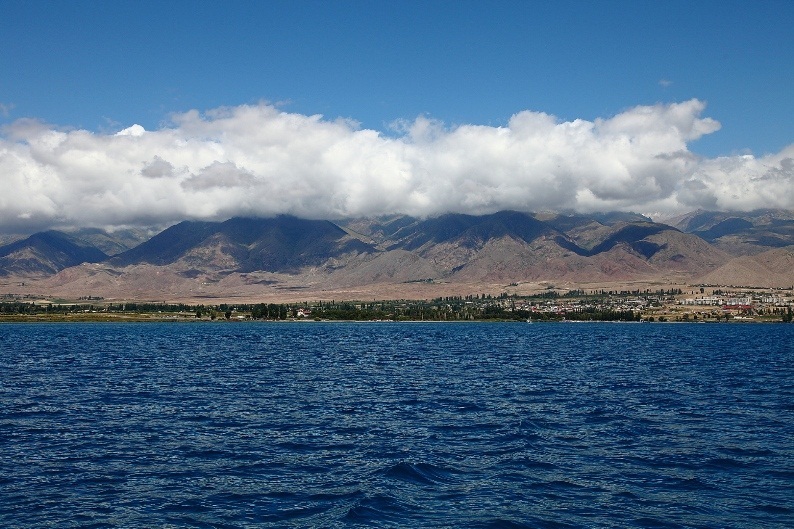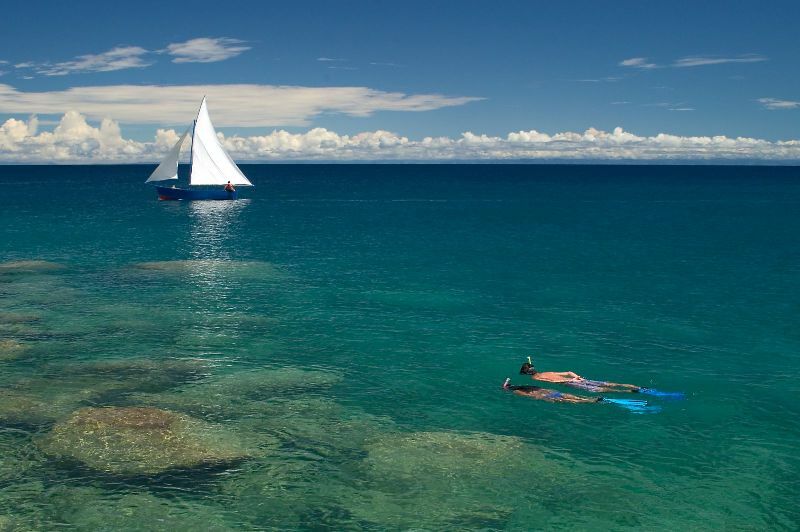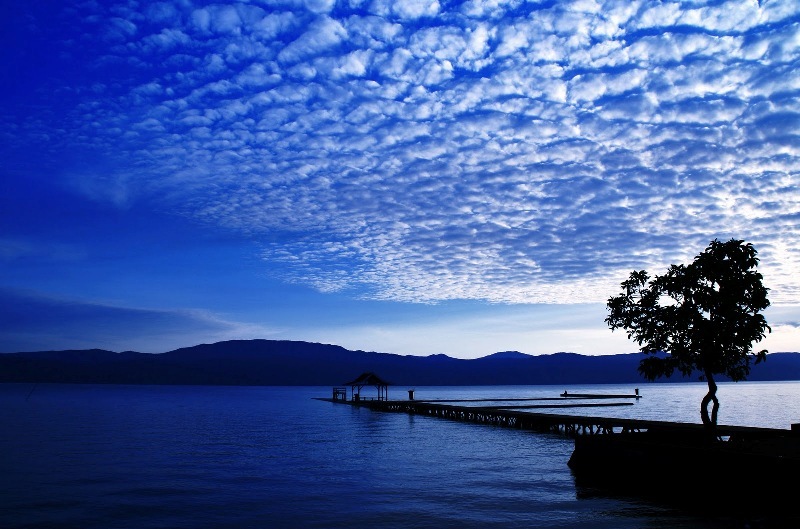9-place: The crater is a crater lake that has a depth of 594 meters. Kreiter - is the deepest lake in the US and the second deepest in North America. This lake is the main attraction of the homonymous national park, located in the state of Oregon. Lake Creater was formed in a deep volcanic basin( caldera) more than 7 thousand years ago due to the destruction of the Mount Mazam volcano. Thanks to the melting of snow, the water in the lake is very clean and blue. Lake Creight has an unusual sight - a huge log called "Lake old man", has been floating in the pond for more than a century in an upright position. In 2005, Creuther Lake was captured on the Oregon Jubilee Coin.

8th: The Great Slave Lake - is the deepest lake in Canada and the whole of North America .Its maximum depth reaches 614 meters. Eight months of the year, the surface of the lake is icebound, which is so thick in winter that a heavy truck can withstand it. In the 1930s, gold was found here, which was the reason for the founding on the shores of the lake of the city of Yellowknife.

7th place: Issyk-Kul is a saltless lake in the northern part of the Tien Shan mountains in Kyrgyzstan. The maximum depth of this deepest lake in Central Asia is 702 meters. From the Kirghiz language "ysyk kel" is translated as "hot lake".This name was received due to the fact that its brackish water does not freeze even in severe winter. Several interesting legends and stories are connected with Lake Issyk-Kul. According to one of them, an ancient Armenian monastery with the relics of St. Matthew is kept in the lake. Another legend says that it was in this place that the soldiers of Tamerlane stacked their famous pyramids from stones. In 2006, at the bottom of the lake, traces of the ancient civilization were discovered, which existed 2,5 thousand years ago.

6th place: Malawi ( another name is Nyasa ) is the southernmost of the lakes of the East African rift valley, located between Mozambique, Malawi and Tanzania. This is the second deepest lake in Africa - its maximum depth is 706 meters. In the tropical waters of Malawi, there is the largest species diversity of fish among all the lakes of the Earth. Scientists have come to the conclusion that over the last 100 thousand years the depth of the lake has decreased by more than 100 meters. The causes of water losses are surface evaporation( up to 80%) and the Shire River flowing from the southern part of the lake.

5th place: San Martin ( another name is O'Higgins ) is a fjord-like lake in Patagonia, located on the border of Argentina and Chile at an altitude of 250 meters above sea level. The area of the lake is 1058 km ², and the depth is 836 meters. This is the deepest lake in South America, .In Argentina, the lake is called San Martin, in Chile - O'Higgins. The lake is named after the national heroes of Jose de San Martin from Argentina and Bernardo O'Higgins of Chile, who together fought for the freedom of South America. The lake feeds on the waters of the Mayer River and small glacial streams, but flows into the Pasqua River, which flows into the Pacific Ocean. A unique feature of the lake is the milky blue shade of water, which arises from particles of stone deposits falling into the lake together with the melted waters of glaciers and settling on its bottom.

4th place: The Caspian Sea - is the largest on the planet, a drainless lake with salt water, called the sea due to the fact that its base is the Earth's crust of the oceanic type. Located between Europe and Asia, the lake is washed by the shores of five countries - Russia, Iran, Kazakhstan, Azerbaijan and Turkmenistan. The maximum depth of the Caspian reaches 1,025 meters, and its area is 371,000 km².More than 130 rivers flow into the lake, the largest of them is the Volga. The Caspian Sea has a rich fauna - it is home to the Caspian seal, many sturgeon, and some fish species are found only here. This huge pond is a rich source of energy resources. To date, the total cost of oil and gas at sea is 12 trillion.dollars.

3rd place: East - is the deepest and largest of all the subglacial lakes on the Earth , covered with a thickness of ice of 4 kilometers. A unique reservoir is located in Antarctica, near the Russian Antarctic station "Vostok", in honor of which it got its name. The estimated maximum depth of the lake is over 1200 meters. The lake was opened in 1996.In February 2012, Russian scientists reached the surface of Lake Vostok, drilling an ice shell which lasted 20 years. Studies of the lake can give a lot of useful information to the world, because the conditions in it are similar to those that existed many millions of years ago, besides there is the assumption that such lakes are on the satellites of Jupiter.

see also The coldest places on Earth
2nd place: Tanganyika is the deepest lake in Africa and the second deepest( 1470 meters) in the world. It is also the world's first longest lake( 673 km.), Belonging to four countries - Tanzania, Congo, Burundi and Zambia. The lake is in the deepest tectonic depression in Africa. It was accidentally discovered in 1858 by British researchers John Spic and Richard Burton, who discovered him while searching for the source of the Nile. The lake feeds on several channels, and from it flows only one river - Lukuga. In Tanganyika there are crocodiles, hippopotamus, many waterfowl, as well as many unique species of fish. After the story of the 9-meter-long crocodile killer was published in the National Geographic magazine, which caused the death of several dozen people, Lake Tanganyika was for a long time an object of special interest.

1st place: Baikal is the deepest lake of Russia, Eurasia and the whole world , reaching in depth of 1642 meters. Located in the south of Eastern Siberia, the reservoir is the largest natural reservoir of fresh water - it stores 20% of the total reserve of surface fresh water on the planet. The volume of water in Lake Baikal is greater than in all the lakes of the United States combined. Baikal is also known as the oldest lake on Earth, formed 25-35 million years ago, although usually the lake does not exist more than 15 thousand years. Baikal is a unique ecosystem, there are about 1700 species of flora and fauna here, many of which are nowhere to be found. The lake is listed as a UNESCO World Heritage Site.

see also
's largest lake area Lakes are natural reservoirs formed in depressions of the land, which contain 67.4% of all fresh water of the Earth. The size and depth of the lakes can be very different, and some of them by these indicators are significantly superior to many seas.
In this review presents the ten deepest lakes in the world .
10th place: Matano is a lake of tectonic origin, located in the south of the Indonesian island of Sulawesi. Its depth is 590 meters. Matano is the deepest lake in Indonesia. Lake Matano is an important source of fresh water in Indonesia, famous for its crystal clear waters, inhabited by many rare species of plants, fish and crustaceans. On its shores are deposits of nickel ore. In Matano, the Patea river takes its source, which, flowing through the waterfall, flows into the lake of Mahalon.

